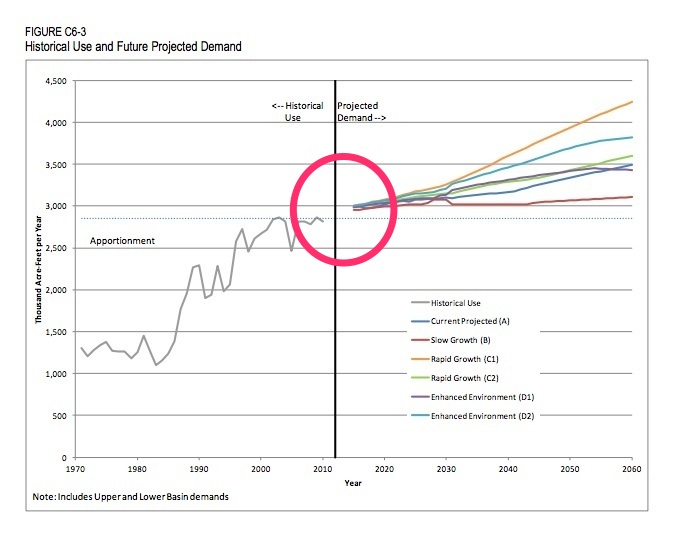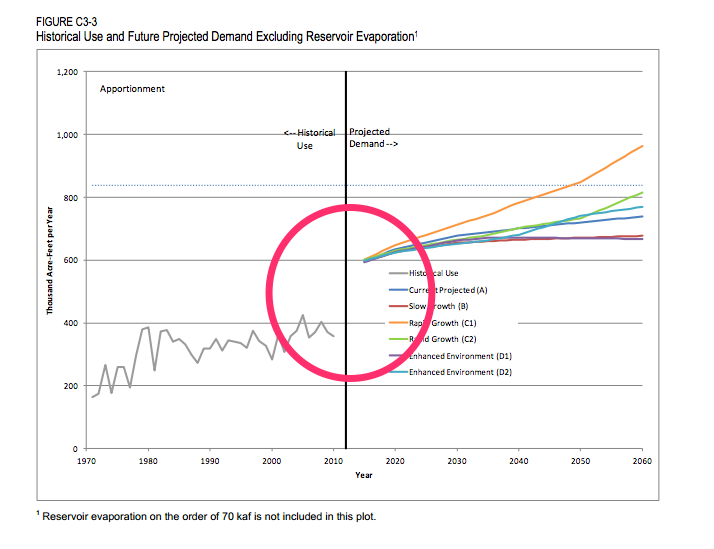Kyle Mittan had some nice straight talk recently in the Tucson Weekly from the University of Arizona’s Sharon Megdal about Arizona’s projections that it’ll need another million acre feet per year of water by 2060:
“A million acre-feet is a lot of water,” she said. “But is that the right number, or is that symbolic of the fact that if communities in the state wish to grow and develop in the ways they’re anticipating now, there’s going to be a need to figure out how to meet the water needs?”
Embedded in the U.S. Bureau of Reclamation’s 2012 Colorado River Basin Water Supply and Demand Study is a lot of questionable data of the following form:
You can see that for a decade, Arizona’s water use flat-lined. And yet the projections call for a big jump and continued rise in water use, well above the state’s available Colorado River apportionment. That obviously can’t happen, and in response one of a number of things will happen. Arizona’s water use will stop rising (which seems to be supported by the history of the past decade) or Arizona will find more water.
I don’t mean to single out Arizona here. Its water use projections in the Basin study are among the least daft. Consider my own state of New Mexico:
A projected 50 percent increase in water demand over a five year period, after a decade that’s been mostly flatlined? That’s crazy!
When I was a youngster, during the dawning of my Earth Day consciousness in the early 1970s, I was a maniac about recycling because I heard we were going to run out of landfill space within, like, a decade or something. Of course we didn’t, because we built new landfills. That realization – hey, people adapt by building new landfills! – drives a lot of my thinking about water today. We obviously can’t use negative water, so the graphs you frequently see showing water demand outstripping supply – a million acre feet! – are crazy talk. Faced with hard choices, Arizonans (and New Mexicans and everyone else) will either figure out how to get more water, which seems expensive and hard, or figure out how to use less, which so far has been a very successful path, as the graphs above demonstrate. At least the left-hand sides of the graphs showing actual historical use. The right-hand sides of the graphs seem to me like a bizarre unreality.
I don’t mean to criticize the Basin Study here, because I think it’s done an enormously valuable service. The study’s authors simply asked the states what they thought they would need, and worked through the results. It’s an incredibly useful exercise if we take the right message away from planning exercises like these – what people say they think they will need is a good starting point for thought exercise Megdal suggests.



Pingback: Blog round-up: What the Republican gubernatorial candidate thinks about the BDCP and more; Jerry Meral on droughts, recessions, and ballot measures, plus tax wars, negative water, drought and desal, and lots more … » MAVEN'S NOTEBOOK | MAV
Pingback: Blog round-up: What the Republican gubernatorial candidate thinks about the BDCP and more; Jerry Meral on droughts, recessions, and ballot measures, plus tax wars, negative water, drought and desal, and lots more … » MAVEN'S NOTEBOOK | MAV
Pingback: Blog round-up: What the Republican gubernatorial candidate thinks about the BDCP and more; Jerry Meral on droughts, recessions, and ballot measures, plus tax wars, negative water, drought and desal, and lots more … » MAVEN'S NOTEBOOK | MAV
Pingback: Blog round-up: What the Republican gubernatorial candidate thinks about the BDCP and more; Jerry Meral on droughts, recessions, and ballot measures, plus tax wars, negative water, drought and desal, and lots more … » MAVEN'S NOTEBOOK | MAV